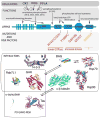LRRK2 Pathways Leading to Neurodegeneration
- PMID: 26008812
- PMCID: PMC5839465
- DOI: 10.1007/s11910-015-0564-y
LRRK2 Pathways Leading to Neurodegeneration
Abstract
Mutations in LRRK2 are associated with inherited Parkinson's disease (PD) in a large number of families, and the genetic locus containing the LRRK2 gene contains a risk factor for sporadic PD. The LRRK2 protein contains several domains that suggest a role in cellular signaling, including a kinase domain. It is also clear that LRRK2 interacts, either physically or genetically, with several other important proteins implicated in PD, suggesting that LRRK2 may be a central player in the pathways that underlie parkinsonism. As such, LRRK2 has been proposed to be a plausible target for therapeutic intervention, with kinase inhibition being pursued most actively. However, there are still several fundamental aspects of LRRK2 biology and function that remain unresolved at this time. This review will focus on the key questions of normal function of LRRK2 and how this might be related to the pathophysiology of PD.
Figures

References
-
- Polymeropoulos MH, Lavedan C, Leroy E, et al. Mutation in the alpha-synuclein gene identified in families with Parkinson’s disease. Science. 1997;276:2045–7. - PubMed
Publication types
MeSH terms
Substances
Grants and funding
LinkOut - more resources
Full Text Sources
Other Literature Sources
Medical
Research Materials

